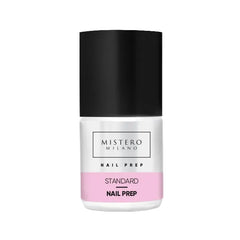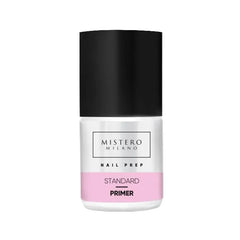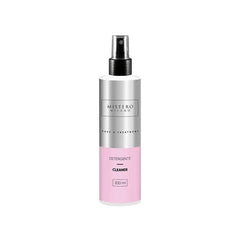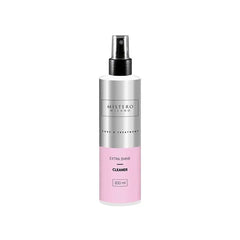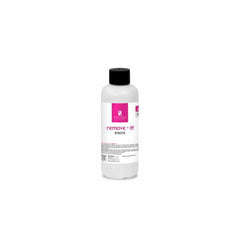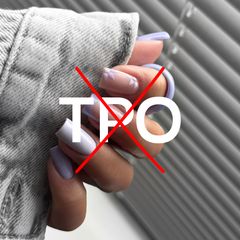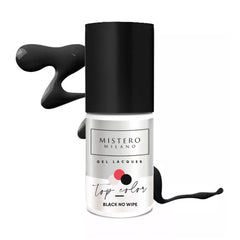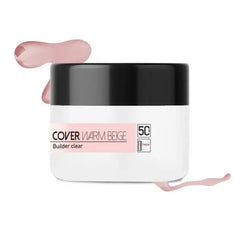Liquids
Amber D'Halluin
1. Nail prep
1.1 What is nail prep?
Nail prep is also often called a dehydrator. It is a product that removes moisture from the natural nail plate, which allows a base coat to adhere better. Nail prep ensures that all moisture evaporates from the upper surface of the nail plate. Your nail plate will temporarily and locally dry out. We are only talking about the upper layer, not your entire nail will be dried out. The temporary drying out of the nail plate has no harmful effect. Thirty minutes after applying the nail prep, the nail plate will contain the normal amount of moisture again. So always make sure that you do not wait too long to apply the nail products.
It is important to have cleaned your nails thoroughly before applying nail prep. After applying nail prep, it is recommended not to touch your nails with your fingers. This will cause the nail plate to immediately become moist and greasy again. Blowing also has a negative effect on nail prep due to the moisture in your breath. In the event of a side effect of your artificial nails, it is important that you only apply nail prep to your natural nail plate.
If the nail plate is not cleaned properly before applying the nail prep, the bottle will be contaminated with oils that were present on your nails. Due to the contamination of the nail prep, it is important to never refill the bottle, but to use a new one when the old one is empty. A contaminated bottle will cause your nails to become even more contaminated over time, with the logical consequence of lifting and shorter durability. Nail prep also has a degreasing effect on your nails, but this is not their actual primary function.
1.2 How to use nail prep?
Nail prep should be applied thinly to a prepared nail plate. The natural nail plate should already be buffered and dust free. The liquid should be allowed to evaporate completely before applying a primer.
2. Primer
2.1 What is a primer?
A Nail primer , also known as bonder, is a product that improves the adhesion of the artificial nail to the natural nail plate. Primer may only be applied to the natural nail plate. Within the primers you have two types: acidic and acid-free primer. The latter has not been known for long in the nail world.
2.2 The difference between acidic and acid-free primer
Acid primers are made on the basis of methacrylic acid and work like double-sided tape. Contrary to what you might think, primer does not feel sticky. How is this possible? The molecules of an acid primer can be compared to a person who has two arms. The left arm is attracted to the nail plate while the right arm chemically bonds with the artificial nail. This creates a bond that ensures very good adhesion. Acid primers are no longer used as often because they are quite aggressive when accidentally applied to the skin. Acid primers are usually still recommended for people with a problematic or very oily nail plate. This can also offer a solution for people with hormonal problems.
Some acid-free primers can be compared to the acidic primer, but use a different base substance. Most acid-free primers, on the other hand, will form a direct chemical bond with the keratin layer of the nail plate. These primers are less aggressive than the acidic version while still offering a very good bond to the nail plate.
2.3 How should you use primer?
Apply a thin layer of primer after the nail prep has evaporated. After the primer has evaporated, a sticky layer is created, this layer is completely natural. Make sure that you never apply primer to the skin, because this can lead to dehydration of the skin.
3. Cleaner
3.1 What is cleaner?
Immediately nail cleaner can remove the sticky layer that is created during the curing of artificial nails. In addition to removing the sticky layer of UV curing products, it is also used to degrease the natural nail plate. In our range you have three types of cleaners: the detergent / glass-on! and the extra shine cleaner.
The biggest difference between these two types is that the extra shine cleaner contains oil. When you use this cleaner to remove the sticky layer, you will have artificial nails with a greater shine as a result. Keep in mind that you should not use cleaners with oil in between steps of a manicure, because this causes lifting of the nail.
The detergent or Glass-on! is used to prepare nails for a manicure, in other words to remove the natural oils from the nail plate. You can also use it to remove uncured UV products.
3.2 How should you use cleaner?
Moisten a cellulose swab with a cleaner and then wipe off the sticky layer from the cured nails.
4. Remover
4.1 What is remover?
A remover softens the artificial nails so that you can easily remove them. The removers from the Mistero Milano range also have a degreasing function. This means that you can also use them to clean the nail plate and prepare it for subsequent treatments.
4.2 How should you use remover?
You can use remover in 2 ways:
- Pour some remover into a glass bowl and let your nails soak for about five minutes. This will soften your artificial nails, gently push the nail product away with a cuticle pusher or wooden stick.
- Put the appropriate amount of cleaner on a cellulose swab and apply it to the nail. Then clamp it with soak off clips, after five minutes you can gently remove the nail product with a wooden stick or cuticle pusher.
Remember to apply cuticle oil to your cuticles to protect them.
4.3 Heating the remover speeds up the weaning process
Heating up a remover makes the soaking process more efficient. Every remover works faster when it is slightly heated. Make sure that it is heated safely, especially when working with highly flammable remover. You can heat the remover by putting it in a plastic bottle that is not completely closed and heating it in warm water (not on a hot plate). Do not heat remover higher than 40°C. When heating your remover, remember not to smoke in the room and do not heat it near open flames or very hot objects.
With the normal removal method, the remover is also heated. Your hands also give off heat, about 36°C. This way, the remover is heated in the foil, which speeds up the soaking process.
4.4 Why should one product deviate longer than another?
One coating is easier and faster to soak off than the other, this has to do with the porosity of the coating. The porosity of the product determines the penetration speed of remover. Acrylic and gel polish are easier and faster to remove because they are more porous than gel and acrylic gel.



